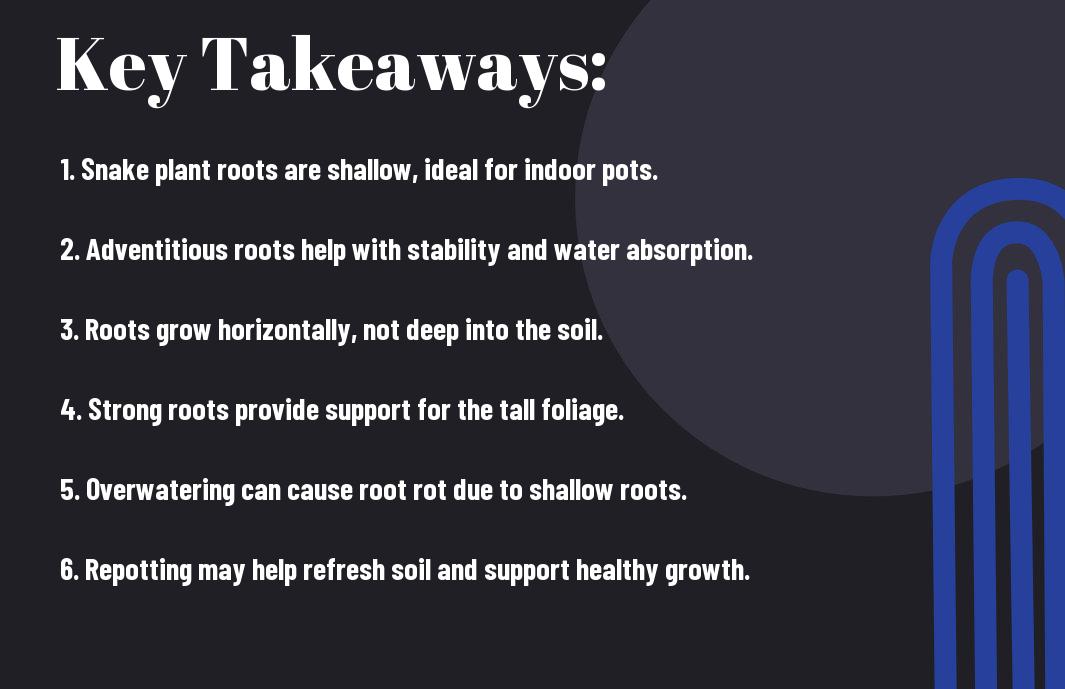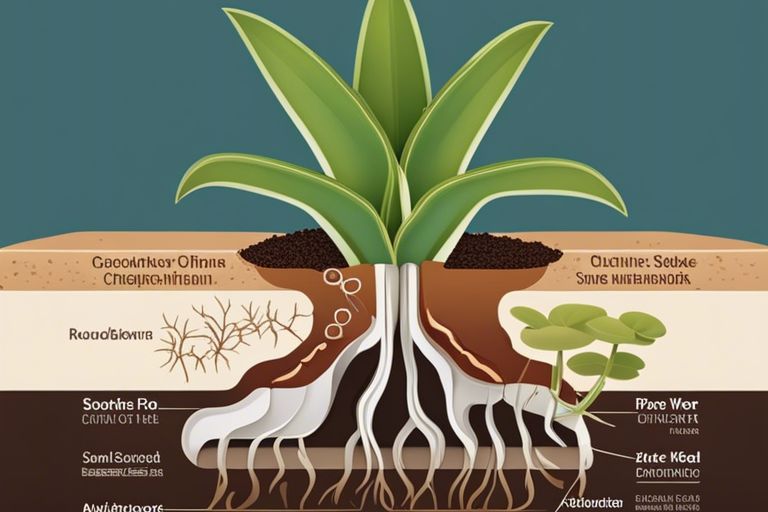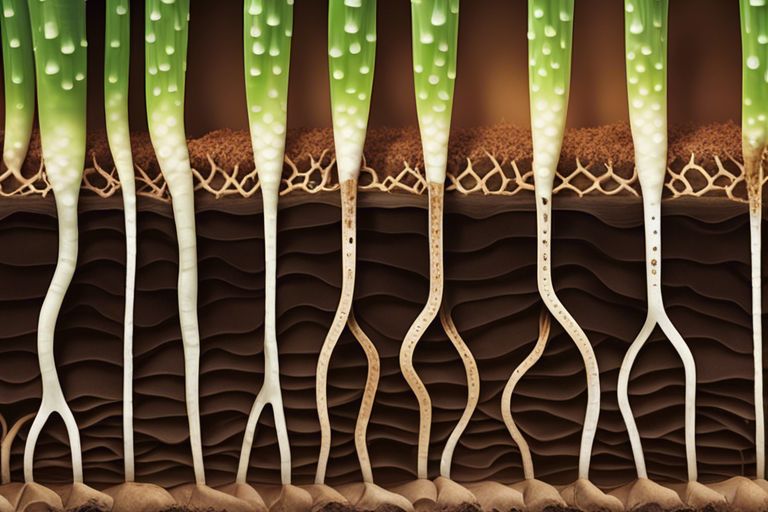With their hardy nature and air-purifying qualities, snake plants, also known as Sansevieria, have become a popular choice for indoor plant enthusiasts. However, understanding the root system of these plants is vital for their proper care and maintenance. In this blog post, we will research into the depth and characteristics of snake plant roots, uncovering the secrets beneath the surface.
Key Takeaways:
- Shallow Root System: Snake plants have shallow roots that spread horizontally near the surface of the soil.
- Adapted for Drought: The shallow root system of snake plants helps them efficiently absorb water during rainfall and store it for long periods, making them drought-resistant.
- Be mindful of Overwatering: Due to their shallow roots, snake plants are susceptible to root rot if overwatered. It is necessary to provide well-draining soil and allow the top few inches to dry out between waterings.


Anatomy of Snake Plant Roots
Root Types and Functions
All Sansevieria plants have a well-developed root system that plays a crucial role in their overall health and survival. The roots of a Snake Plant serve several important functions to support the plant’s growth and well-being.
- Absorption: The primary function of Sansevieria roots is to absorb water and nutrients from the soil.
- Anchor: The roots anchor the Snake Plant in the soil, providing stability and support for the above-ground foliage.
- Storage: Some Sansevieria species store water and nutrients in their roots, allowing them to survive in arid conditions.
- Aeration: Roots also play a role in gas exchange, allowing oxygen to reach the plant’s underground organs.
- Propagation: Sansevieria roots can be used for propagation, allowing new plants to form from cuttings or offsets.
Any issues with the root system can have a direct impact on the health and vitality of the Snake Plant as a whole. Understanding the anatomy of Sansevieria roots is crucial for proper care and maintenance of these popular houseplants.
Physical Characteristics of Sansevieria Roots
Role: The root system of Sansevieria is well-adapted to its epiphytic nature, with specialized structures that enable it to thrive in various growing conditions. The roots of a Snake Plant are typically rhizomatous or fleshy, designed to store water efficiently and provide stability in the soil.
Sansevieria roots are known for their ability to withstand drought conditions, making them ideal for novice plant owners or forgetful waterers. The thick and succulent roots are also a key adaptation for surviving in nutrient-poor soils, as they can store reserves for extended periods. To ensure the health and longevity of your Snake Plant, it is crucial to provide well-draining soil and avoid overwatering, as root rot can quickly become a serious issue.
Growth Patterns of Sansevieria Roots
Once again, let’s examine into the fascinating world of Sansevieria roots. The growth patterns of Sansevieria roots are quite unique compared to other houseplants. These plants are known for their rhizomatous root system, which means they have thick, fleshy roots that store water and nutrients. The roots of Sansevieria grow in a horizontal and shallow manner, spreading outwards rather than digging deep into the soil.
Factors Influencing Root Development
For Sansevieria plants, the root development is influenced by several factors. Some of the key factors that can affect the growth of Sansevieria roots include:
| Factors | Description |
| 1. Light | Sansevieria roots thrive in bright, indirect light. |
| 2. Watering | Overwatering can lead to root rot, affecting development. |
| 3. Soil | Well-draining soil is crucial for healthy root growth. |
Any imbalances in these factors can hinder the development and growth of Sansevieria roots.
Seasonal Variations in Root Growth
An interesting aspect of Sansevieria root growth is how it varies with the seasons. During the growing season, typically in spring and summer, the roots of Sansevieria tend to expand and grow more rapidly. This is the time when the plant is actively absorbing nutrients and water to support its above-ground growth.
Plus, in the dormant season of fall and winter, Sansevieria roots may slow down their growth as the plant enters a resting phase. It is important to adjust your care routine accordingly during these seasonal variations to promote optimal root health.

Measuring Root Depth in Snake Plants
Not all plant roots are created equal. Pertaining to snake plants, also known as Sansevieria, understanding the depth of their roots can provide valuable insights into their growth patterns and care requirements. In this chapter, we examine into the techniques for accurately measuring the root depth of snake plants.
Techniques for Assessing Root Depth
Plants can offer subtle clues about their root system, such as bulging at the base of the pot or roots peeking out from the drainage holes. To get a more precise measurement, gently tap the plant out of its container and examine the root ball. For a non-invasive method, consider using a soil probe to measure the depth at which roots are present. These techniques can help you determine the overall health and development of your snake plant’s roots.
Average Depths Observed in Sansevieria
On average, snake plants exhibit root depths ranging from 6 to 12 inches, depending on the species and age of the plant. The roots tend to grow deep rather than wide, allowing them to seek out water and nutrients efficiently. This characteristic makes snake plants resilient and well-suited for various growing conditions.
Method: By carefully monitoring the root depth of your snake plant, you can assess its overall health and make informed decisions regarding watering frequency and pot size. Understanding the typical root depths observed in Sansevieria can guide you in providing optimal care for these charismatic plants.
Factors That Affect Root Depth
For a deeper understanding of the root system of the Sansevieria plant, it is crucial to explore the factors that influence root depth. Several key elements can impact how deep the roots of a Snake Plant grow.
- Pot Size and Shape
- Soil Composition and Nutrient Availability
- Watering Practices
- Light Exposure
Any changes in these factors can have a significant effect on the development and structure of the Snake Plant roots.
Impact of Pot Size and Shape
To examine the influence of pot size and shape on root depth, consider that the root system of a Sansevieria will grow to the limits of the container it is planted in. A small or shallow pot will constrain the roots and inhibit their downward growth. In contrast, a larger and deeper pot will allow the roots to spread out and grow more freely, resulting in a deeper and more extensive root system.
Soil Composition and Nutrient Availability
For optimal root development, the soil composition and nutrient availability play a crucial role. Snake Plants thrive in well-draining soil that is rich in organic matter. A balanced mix of nutrients is crucial for healthy root growth and overall plant health. The presence of adequate nutrients in the soil will promote root development and enable the Sansevieria to establish a robust root system.
Depth is a critical factor in determining the overall health and vitality of the Snake Plant roots. A deep and well-established root system ensures efficient water and nutrient uptake, enhancing the plant’s resilience to stress and environmental fluctuations.
Root Depth and Plant Health
Your How deep are the roots of a snake plant supposed to? inquiry is a common concern for many plant enthusiasts. The root system of a snake plant, also known as Sansevieria, typically grows shallow and horizontally. This unique root structure aids in the plant’s adaptation to various environments, including those with limited space or poor soil quality.
Signs of Healthy vs. Unhealthy Root Systems
Plant health is often reflected in its root system. When examining the roots of your snake plant, look for firm, white roots indicating vitality. Healthy roots promote plant growth and water uptake. In contrast, unhealthy roots may appear brown, mushy, or have a foul odor, signaling issues such as root rot or dehydration.
Preventing and Treating Root-Related Issues
Any negligence in plant care can lead to root-related problems. To prevent issues, ensure your snake plant is potted in well-draining soil and a container with drainage holes. Overwatering is a common cause of root rot, so it’s necessary to let the soil dry out between waterings. If you suspect root rot, gently remove the affected roots, trim as needed, and repot the plant in fresh soil.
The key to maintaining a healthy root system in your snake plant is to strike a balance in watering and provide adequate drainage. Regularly inspecting the roots during repotting or routine checks can help you address any issues promptly and ensure the long-term health of your plant.
Root Depth in Relation to Propagation and Transplantation
Propagating Sansevieria
After researching the root depth of snake plants, it is necessary to understand how this knowledge can impact propagation techniques. An interesting fact about snake plants is that they can be propagated through division or leaf cuttings. When propagating through division, it is crucial to ensure that each new plant has a sufficient amount of healthy roots, as they store nutrients and help the plant establish itself in its new environment. Propagation of snake plants can be successful when the new plantlet has developed its own root system, ensuring its ability to thrive independently.
Transplanting Mature Snake Plants
After gaining insight into the depth of snake plant roots, it is important to consider how this information can guide the process of transplanting mature plants. Transplanting mature snake plants requires careful handling to avoid damaging their extensive root system. These plants are sensitive to root disturbance, so it is crucial to minimize shock during the transplanting process. Transplanting snake plants should be done during the warmer months when the plant is actively growing, increasing the chances of successful establishment in their new container.
To ensure a successful transplanting process for mature snake plants, it is recommended to carefully loosen the roots at the edges of the root ball before transferring the plant to a new container. This technique helps the roots adapt to their new environment more easily, promoting healthy growth and development. Avoid over-watering the plant immediately after transplanting, as this can lead to root rot due to the plant’s roots being in a state of shock and more vulnerable to moisture-related issues.
To wrap up
Ultimately, delving into the root system of the snake plant, also known as Sansevieria, reveals a surprisingly shallow root structure despite its reputation for being a hardy and resilient plant. The Sansevieria’s roots, while extensive, tend to spread horizontally close to the surface rather than digging deep into the soil. This unique root system allows the snake plant to thrive in various environments with limited root space, making it an ideal plant for indoor spaces.
To conclude, understanding the depth of snake plant roots sheds light on its adaptability and low-maintenance nature. By grasping the root system of Sansevieria, plant enthusiasts can better care for and appreciate this popular houseplant, ensuring its continued growth and health for years to come.
